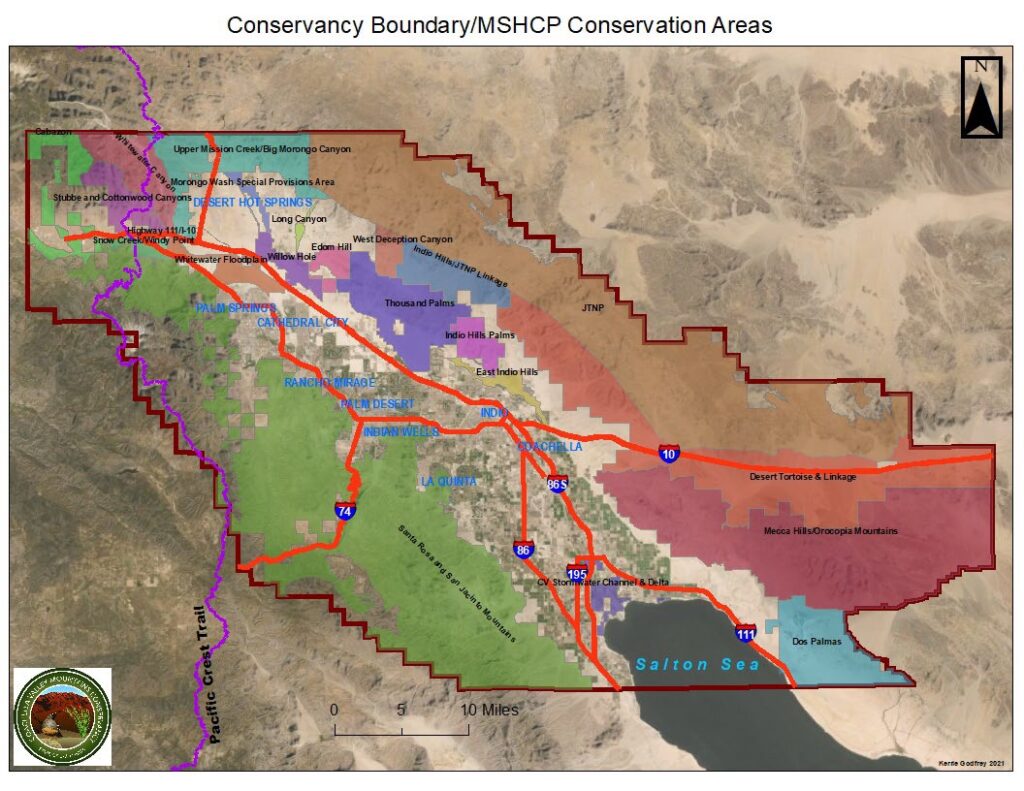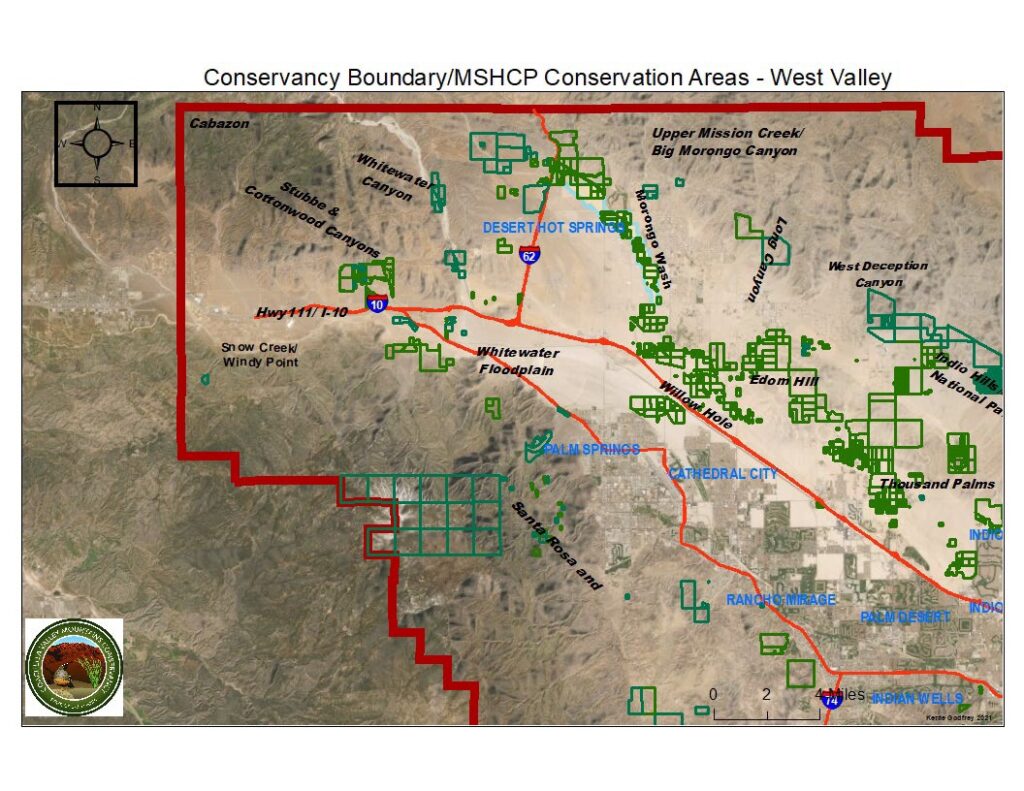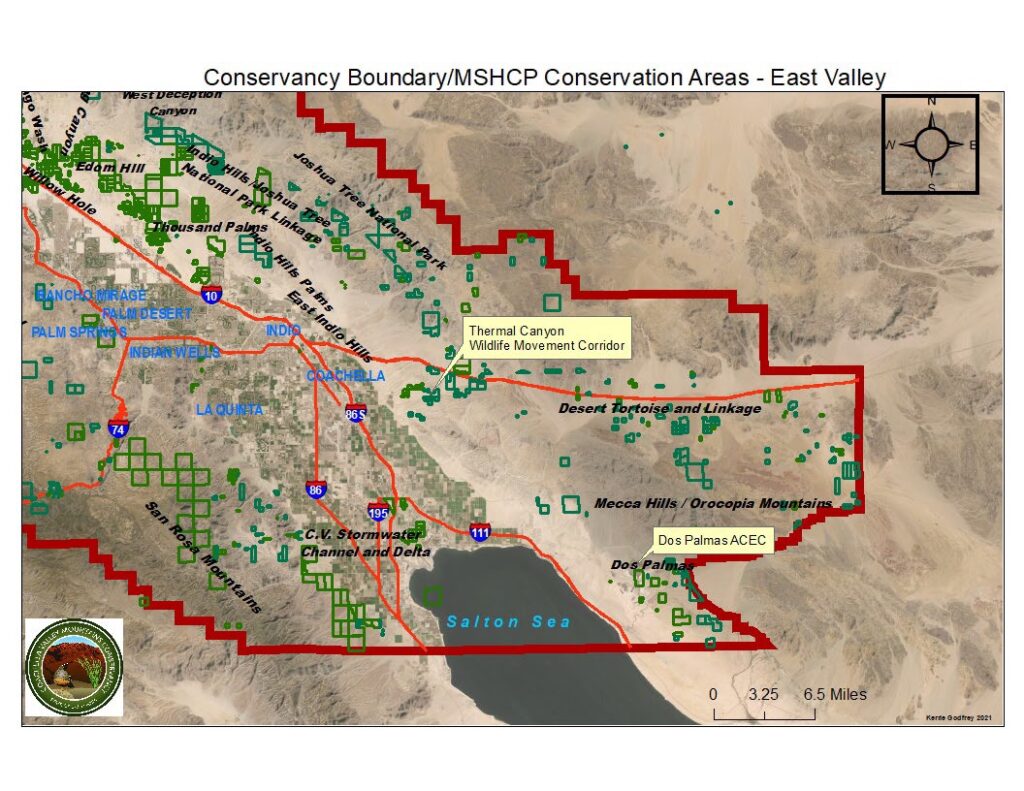Coachella Valley Mountains Conservancy Acquisition Priorities 2022
The Conservancy’s mission under state law is to protect lands with “open-space, wildlife, scenic, environmental, anthropological, cultural, scientific, educational and recreational resources”, including both mountainous lands surrounding the Coachella Valley and natural community conservation lands as identified in the Coachella Valley Multiple Species Habitat Conservation Plan (“CVMSHCP”). The priorities set forth here update and revise the Acquisition Priorities set by the Conservancy Board in January 2020. The priorities establish initial criteria for evaluating potential acquisitions (or applications for grants for acquisitions), with the understanding that ranking particular properties can be a subjective exercise and that the circumstances surrounding the availability of willing sellers or funds to support purchases will necessitate careful analysis of each site.
All acquisition properties must be within a CVMSHCP Conservation Area or if outside, must directly support the CVMSHCP or significantly assist in fulfilling California’s 30 by 30 objectives, and must preserve or promote one or more of the following conservation objectives:
- Biological resources, such as important plant or wildlife habitat or hydrologic features or potential to enhance carbon sequestration
- Cultural resources
- Recreational options consistent with habitat values
- Significant scenic attributes.
In general, properties that fulfill more than one of the conservation objectives will be preferred for acquisition to those that meet only one objective. However, each potential acquisition site is unique and the ultimate decisions on acquisition will rest with the Conservancy’s board.
Other attributes or factors in establishing priority:
- Likelihood of imminent or future development
- Potential to expand access to open space for historically underserved communities
- Importance for responding to climate change, such as sites for vegetation projects to enhance carbon sequestration
- Partnership or fund leveraging opportunities
- Potential for future transfer to federal or local agency or non-profit organization
- Adjacent to or near other conservation holdings where cooperative monitoring and management is feasible
- Availability of public agency or nonprofit entity to take and hold title
- Funding options for future management and monitoring
- Rising land values in area
- Potential for use as part of other Conservancy program, e.g., habitat restoration or trail or other outdoor recreational projects
- Other special circumstances, e.g., seller motivation, foreclosure or tax sale offering, property condition, presence of improvements or hazardous materials.
The Conservancy’s jurisdiction, which matches the CVMSHCP territory, includes 1.2 million acres, stretching from the Banning pass on the west, to the top third of the Salton Sea on the east, to Joshua Tree National Park (JTNP) on the north and to the Santa Rosa & San Jacinto Mountains National Monument (SRSJNM) on the south. The CVMSHCP has designated 21 habitat conservation areas (map attached as Exhibit A) and protects 40 covered species throughout the Coachella Valley. Under the CVHSHCP, approximately 747,000 acres will eventually need to be conserved.
The following updated list highlights recent progress the Conservancy and its partners have made in key conservation areas and shows where our priorities will be in the coming years:
- San Jacinto Mountains (including the Chino Cone area) and Santa Rosa Mountains alluvial fans (in La Quinta, Oasis, Thermal, Vista Santa Rosa, Snowcreek and Palm Hills) – contain cultural resources, scenic resources within and adjacent to the SRSJNM and significant habitat values for Peninsular bighorn sheep, along with future recreational options. Major recent acquisitions have included the 640 – acre Shumway Ranch, 114+ acre – Oswit Canyon, 560 acres known as Shadowrock and Angel Cove, 640 acres known as the Schlesinger property, 481 acres in the San Jacinto Mountains above Snowcreek, and a 42+ acre site in Palm Springs known as the Rimrock property. Efforts are continuing to acquire the remaining critical properties in or near the SRSJM.
- Lake Cahuilla shoreline – protects this unique historical shoreline and important cultural resource area from potential development and connects it to other conservation areas. The Conservancy board has approved several acquisition grants to our partners here, and while purchase activity has slowed down, we remain open to prospective acquisitions. While most major private holdings here have been conserved, efforts are continuing to acquire the remaining critical properties in or near the shoreline.
- Stubbe Canyon corridor – includes significant wildlife corridor between the San Jacinto and San Bernardino Mountains, sand transport essential areas and high-quality riparian habitat, as well as trail alignment opportunities. Due to the threat of development, the Conservancy has been very active in this area. As the Pacific Crest National Scenic Trail passes through and is adjacent to several of the conservation parcels, there are future trail alignment opportunities as well. We continue to negotiate with willing sellers in this area.
- Sand transport areas in Upper Mission Creek/Big Morongo Canyon, Willow Hole, Thousand Palms and Edom Hill areas – where many parcels provide excellent habitat for the Coachella Valley Fringed-Toed Lizard (CVFTL), Coachella Valley milkvetch, Coachella valley round-tailed ground squirrel, and Palm Springs pocket mouse. The Conservancy has focused heavily on acquisitions in these areas, succeeding in acquiring a good portion of the “low hanging fruit” to date. Many remaining sites contain cultural resources and could provide trail alignment opportunities. As there remains a significant threat of development, we are always open to opportunities to acquire additional properties in this area. Recently, using Federal Endangered Species Act funds along with Conservancy bond funds, we facilitated the conservation purchase of 481 acres adjacent to this conservation area and the Sand to Snow National Monument that were proposed for a major housing development.
- Thermal Canyon/Mecca Hills/Orocopia Mountains Wilderness areas, including portions of the Desert Tortoise/Linkage, West Deception Canyon and the Indio Hills/JTNP Linkage Conservation Areas – which contain significant desert dry wash woodland and significant historical resources due to their proximity to the Colorado River Aqueduct. They also serve potential as linkages for wildlife movement corridors among several significant canyons, and some represent future trail opportunities. Efforts are ongoing as willing sellers approach us desiring to sell their properties in this area. We especially hope that eventually the Paradise Valley site may become available.
- Indio Hills/ JTNP Linkage Conservation Area – contains habitat, public access to future State Park facilities and quality “wilderness” area and was the location of the Conservancy’s largest partnership acquisition project of approximately 8,881. In recent years, the Conservancy has continued our acquisition efforts in areas bordering JTNP. The long-term goal is to transfer many properties to the Park Service for inclusion into JTNP. The Conservancy is also working to connect trails from the valley to existing JTNP trails.
- Dos Palmas Conservation Area – contains existing valuable habitat as well as future potential linkages for wildlife movement and connects to other publicly owned land in the Dos Palmas ACEC. Due to the location near the Salton Sea, parcels here may host future cooperative restoration projects using water bond funding. In the last several years, this has been an active area for acquisition work, which is expected to continue.
- Stormwater Channel and Delta Conservation Area – features rare wetland habitat and serves protected riparian birds and other species, provides opportunities for habitat restoration or water quality cooperative projects near the Salton Sea and enhances the CVMSHCP efforts to acquire a large area of continuously conserved parcels. Since 2014, we have acquired several hundred acres here, many of which contain wetlands areas that are now being restored with Conservancy funding.
On the attached Exhibits B and C, the areas in dark green portray the areas in the East and West Valley conserved up to 9/30/21.
Approved by the Coachella Valley Mountains Conservancy Board on January 10, 2022.




